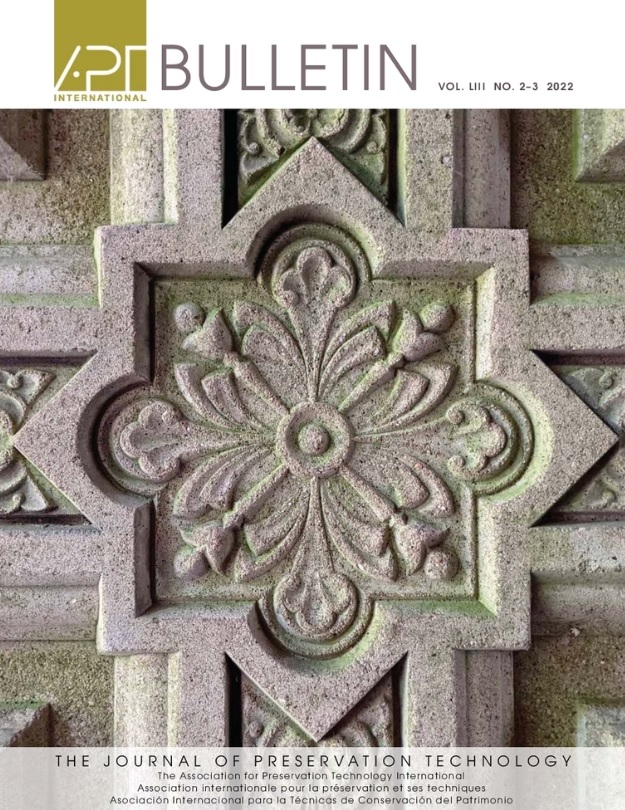The Association of Preservation Technology Bulletin Vol LIII, Numbers 2 to 3, 2022
Regular readers will be aware of this reviewer’s strong advocacy of the Association of Preservation Technology Bulletin, notwithstanding that by being published in the USA it is not always easily accessible in the UK. Its technical content, at the cutting edge of the history of historic environment management, leads to this reviewer considering it to be essential reading. The recent joint issue from 2022 (Vol LIII, Nos 2–3) deals with materials and the architectural assemblies of historic building construction.
Since its inception, the APT Technical Committee for Materials has concentrated on the exchange and dissemination of information on materials by a wide range of means. The team has expounded not only the fundamental physical properties of building and repair materials, but also their chemical composition, how physical and chemical properties relate to performance, and the mechanisms involved in loss of that performance.
Frank Matero focuses on an examination of education in architectural material studies and its influence in shaping the disciplines and professional practice so fundamental to good heritage management practice.
Shirley Cefai and JoAnn Cassar generate an informative discussion on aspects of reconstruction and authenticity, probing how new material used in architectural preservation is important in considering how this concept is addressed, especially when there is a dramatic loss of material and use. There are two instructive examples from southern Europe.
The church of Saint Anthony of Padua in Malta, commissioned by the grandmaster Manuel De Vilhena, built in 1727 and destroyed during the second world war, is compared with the reconstruction of the temple-cathedral of St Procolus in Pozzuoli, Italy, after being damaged by fire in 1964. The cathedral of Pozzuoli was originally commissioned around 1630, while the temple of Augustus dates from the first century AD. The two rebuilt structures resulted in diametrically opposite solutions, utilising very different materials. Original limestone was used in the church in Malta, while glass and metal were used in Pozzuoli, resulting in very different architectural solutions. The paper discusses how the authenticity of both churches was impinged on due to the form of the materials used, which in turn affected their appearance and the experience created.
The most truthful application of historic finishes of architectural elements undergoing multiple restoration and maintenance campaigns is the subject of a paper by Emily Macdonald. She explains the use of materials science to determine appropriate interventions using a combination of historical research, in-situ investigation and laboratory analysis to discover more than just the earliest colours.
Tim Michiels and Dan Bergsagel focus on how a range of building demolition, replacement and renovation scenarios can direct heritage management practice in aiding sustainability and rehabilitation choices, helping to reduce embodied carbon and furthering the idea of sustainable materials preservation.
Brian Goekin provides a focus on how the term ‘substitute material’ is used and how alternative materials might be incorporated in building conservation, by referencing the US National Park Service guidance on substitute materials embedded in Standards for the Treatment of Historic Properties since the 1970s.
The issue concludes with Richard Piper describing the stylistic evolution of cast stone as one of the iconic substitute materials in architecture, and citing helpful references to the origins of its manufacture and use, ubiquity, repair, conservation and replacement.
One valuable element of the APT Bulletin is its regular Practice Point centre section. The series has reached No 24, addressing the subject of terrazzo. Anne T Sullivan presents a full discussion of the material from its history of utilising scrap from the marble industry in Italy through late 19th- and 20th-century cementitious systems to its modern transformation into a polymer-based floor finish. Anybody dealing with conservation or substitution of this material will find Sullivan’s nine-page exposition extremely helpful.
This article originally appeared in the Institute of Historic Building Conservation’s (IHBC’s) Context 176, published in June 2023.
--Institute of Historic Building Conservation
Related articles on Designing Buildings
- Association of Preservation Technology Bulletin Vol LIII, No 1, 2022.
- Conservation area.
- Conservation.
- Heritage.
- Historic environment.
- IHBC articles.
- Institute of Historic Building Conservation.
- Listed buildings.
- Materials.
- Preservation.
- Terracotta.
- The Association of Preservation Technology Bulletin (Vol LII, No 4, 2021)
IHBC NewsBlog
SAVE celebrates 50 years of campaigning 1975-2025
SAVE Britain’s Heritage has announced events across the country to celebrate bringing new life to remarkable buildings.
IHBC Annual School 2025 - Shrewsbury 12-14 June
Themed Heritage in Context – Value: Plan: Change, join in-person or online.
200th Anniversary Celebration of the Modern Railway Planned
The Stockton & Darlington Railway opened on September 27, 1825.
Competence Framework Launched for Sustainability in the Built Environment
The Construction Industry Council (CIC) and the Edge have jointly published the framework.
Historic England Launches Wellbeing Strategy for Heritage
Whether through visiting, volunteering, learning or creative practice, engaging with heritage can strengthen confidence, resilience, hope and social connections.
National Trust for Canada’s Review of 2024
Great Saves & Worst Losses Highlighted
IHBC's SelfStarter Website Undergoes Refresh
New updates and resources for emerging conservation professionals.
‘Behind the Scenes’ podcast on St. Pauls Cathedral Published
Experience the inside track on one of the world’s best known places of worship and visitor attractions.
National Audit Office (NAO) says Government building maintenance backlog is at least £49 billion
The public spending watchdog will need to consider the best way to manage its assets to bring property condition to a satisfactory level.
IHBC Publishes C182 focused on Heating and Ventilation
The latest issue of Context explores sustainable heating for listed buildings and more.

















